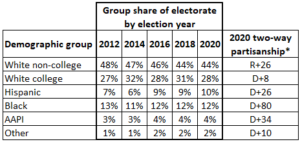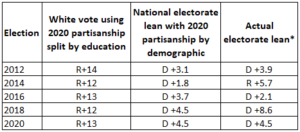“The term “People of Color” is now playing a central role in the Democratic discussion of political strategy because it is described by its advocates as being the key part of a new majority coalition that Democrats could create if they would simply abandon their effort to regain the support of white working class voters.
In an Atlantic article, Ronald Brownstein quotes two advocates of this view:
“The electoral danger in Biden’s strategy of focusing so heavily on recapturing blue-collar voters,” says Steve Phillips, founder of the advocacy group Democracy in Color, is that “Democrats will be so focused on not alienating Whites that they will mute the policy agenda that could excite the sectors of the electorate which are much more receptive… People of Color and young people, [who] are also the growing parts of the population”.…the party would be better served by investing more “in efforts to increase turnout of People of Color especially across the Sun Belt.”
Similarly, Taifa Smith Butler, the new president of Demos, a liberal think tank focused on racial equity, told me, “As this nation becomes majority People of Color you will have to think about the broader coalition of the electorate.” Democrats, she said, “cannot kow- tow” to an older White electorate at the price of sublimating the priorities of “marginalized communities… that we could be lifting up and elevating rather than continuing to try to appease White moderates.”
Obviously, when the term , “People of Color” is discussed this way, it is not just being used as a neutral synonym for “non-white” or non-Caucasian.” It implicitly assumes that these groups actually do form a coherent political coalition that is united by common problems and common interests and that can consequently be counted on to act as a united political force in American politics….
[T]he difficult reality is that major social movements and powerful political alliances between ethnic groups do not arise simply because progressives wish that they would. They emerge because the very distinct historical experiences of different ethnic groups convince them to set aside their differences and work together in unity. This was the experience of the Trade Union movement in the 1930’s when the common brutal conditions in the factories of the era convinced Italian, Polish, East European and Slavic immigrants to mute the profound inter-ethnic conflicts that existed between them and join together to support the organization of trade unions.
In contrast, although both African Americans and Latinos suffered racial prejudice and discrimination, their historical experience since the 1960’s has been quite distinct and has shaped their political consciousness in profoundly different ways….
It was easy to ignore the fact that the majority of Latinos did not define themselves as “People of Color” so long as Latinos voted majority Democratic. In presidential elections since 1980 the GOP generally only won between 25 to 35% of the national vote.
But even long before 2016 a threat could be seen on the horizon. Aloof, rather patrician GOP establishment candidates like George Herbert Walker Bush and Mitt Romney only received 25-30% of the presidential vote but more “down to earth” candidates like Ronald Reagan and George W. Bush received support ranging from the high 30s to as much as 40 percent support for Bush in 2004. George W. Bush had also been quite popular with Latino voters in Texas during his campaigns for governor. It was therefore clear that style and personality could make a significant difference.
And Democrats had also always had problems with the large Cuban exile population in Florida because of the deep anti-Castro sentiments in that community to which Republican candidates very successfully appealed.
Mexican Americans, on the other hand, have been consistently assumed to be “natural” Democrats. As an article in 538.com reported:8
Mexican Americans basically singlehandedly drive the narrative that Latinos are core Democratic voters thanks to their overwhelming numbers: 63 percent of the national Latino population is of Mexican descent, and that figure is even higher in swing states like Arizona, Nevada and Texas.
And they had generally voted more than 2 to 1 in favor of Dems.
But today the fact that Latino support for Trump actually increased in 2020 has profoundly shaken the “natural Democrats” assumption.
According to the Pew validated voter study, one of the most reliable measures of actual voting behavior, the Latino vote for the democratic candidate declined from 66% to 59% between 2016 and 2020 – a 7 point decline. The other most highly regarded source of demographic voting estimates, produced by the Catalyst Institute, used a slightly different calculation – the “two party vote share won by the Democrat” (i.e. excluding third party candidates) – and found that it declined from 71% to 63% – a nearly identical 8 point decline.
This was quite stunning because by 2020 Latinos had had four years to observe Trump’s demonization of Latino immigrants and barely concealed bigotry. Yet instead of voting more solidly Democratic, Latinos actually increased their support for Trump…..
Trump’s campaign recognized that working class Latinos could be successfully appealed to as working people using the same messages that had built Trump’s support among white workers.
As an NBC News postmortem noted:12
Although President Joe Biden won a majority of votes from Hispanics, 59 percent in the 2020 race to Trump’s 38 percent, there was a significant difference in preference based on education, Pew reported.
Biden won 69 percent of college-degreed Latino voters, compared to 30 percent for Trump, a 39 percentage-point advantage. But Biden’s advantage over Trump narrowed with Hispanics with some college or less, 55 percent to 41 percent, a 14-point advantage.
This presented a huge threat because, according to Pew estimates, Hispanics are the most heavily working class group among nonwhites , with 80 percent falling into that category. If future GOP candidates could exceed that 41% level with working class Latino voters, the entire group could essentially become a 50/50 swing voter category rather than part of the Democratic base….
Progressives are endlessly frustrated by the fact that Democratic candidates invariably offer programs that are objectively far more favorable to working class people than those of the GOP. But these arguments invariably run up against the fact that many working class people do not read policy papers or carefully listen to policy debates. They “vote for the candidate, not the platform” and tell pollsters that they base their choices on which candidate they think seems to “care about people like you,” “is on your side,” “will fight for you” or, in the commentator’s most recent cliché, “is someone you would like to have a beer with.”
And Trump, despite his privileged childhood and vast inherited wealth, displayed a blustering, Archie Bunker/Tony Soprano style that seemed more authentic to many working class people than that exhibited by many of the more “typical Washington politician” candidates and media commentators who criticized him.
The GOP also appealed to working class Latinos by focusing attention on the aspects of the Democratic platform that seemed unfavorable to working people or indifferent to their interests. Many working class Latinos in Texas, for example, have good, very high paying blue-collar jobs in the many oil and gas refineries and in pipeline construction and maintenance.
Democratic rhetoric about eliminating fossil fuels seemed to directly threaten their livelihood. A substantial number of Texas Latinos also work in law enforcement, including the Border Patrol, and view rhetoric about “defunding the police” or “open borders” with scorn. GOP commercials made these ideas appear to be the defining elements of the Democratic platform.
More broadly, GOP rhetoric that cast Republicans as “job creators” and defenders of small business seemed plausible to many working class Latinos when contrasted with what Republicans described as the “job-destroying” Democratic agenda. Had Democratic messaging been sharply focused on refuting these attacks they might have been blunted. But, in many cases across the country the primary Democratic appeal to working class Latinos was to emphasize instead Trump’s inhumane policies and disparaging remarks about immigrants.”
There’s a lot more in the full memo. I recommend reading it.






